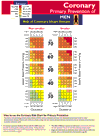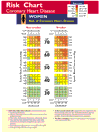The current status of primary prevention in coronary heart disease
- PMID: 11806770
- PMCID: PMC59652
- DOI: 10.1186/cvm-2-1-024
The current status of primary prevention in coronary heart disease
Abstract
During the second part of the twentieth century, research advances caused a substantial decline in the rate of coronary heart disease. The decline lasted from the mid-1960s until the early 1990s and occurred primarily in Western countries. However, an unfavourable trend in coronary heart disease related mortality has gradually developed during the 1990s, with cardiovascular diseases anticipated to remain the main cause of overall mortality for the foreseeable future. The present paper aims at analyzing the current status of the main determinants of population-wide coronary heart disease prevention.
Figures







Similar articles
-
The epidemic of the 20(th) century: coronary heart disease.Am J Med. 2014 Sep;127(9):807-12. doi: 10.1016/j.amjmed.2014.04.015. Epub 2014 May 5. Am J Med. 2014. PMID: 24811552 Review.
-
Cardiovascular disease, a major global burden: Epidemiology of stroke and ischemic heart disease in Japan.Glob Health Med. 2021 Dec 31;3(6):358-364. doi: 10.35772/ghm.2020.01113. Glob Health Med. 2021. PMID: 35036616 Free PMC article. Review.
-
Explanation for the Japanese paradox: prevention of increase in coronary heart disease and reduction in stroke.J Atheroscler Thromb. 2007 Dec;14(6):278-86. doi: 10.5551/jat.e529. Epub 2007 Dec 17. J Atheroscler Thromb. 2007. PMID: 18174657 Review.
-
Did the 1918 influenza cause the twentieth century cardiovascular mortality epidemic in the United States?PeerJ. 2016 Oct 4;4:e2531. doi: 10.7717/peerj.2531. eCollection 2016. PeerJ. 2016. PMID: 27761328 Free PMC article.
-
Lessons from falling coronary heart disease mortality in the United States.Postgrad Med J. 1984 Jan;60(699):15-9. doi: 10.1136/pgmj.60.699.15. Postgrad Med J. 1984. PMID: 6694940 Free PMC article.
Cited by
-
Cardiovascular risk assessment: a global perspective.Nat Rev Cardiol. 2015 May;12(5):301-11. doi: 10.1038/nrcardio.2015.28. Epub 2015 Mar 10. Nat Rev Cardiol. 2015. PMID: 25754885 Review.
-
Current trends in the cardiovascular clinical trial arena (I).Curr Control Trials Cardiovasc Med. 2004 Jun 4;5(1):4. doi: 10.1186/1468-6708-5-4. Curr Control Trials Cardiovasc Med. 2004. PMID: 15180910 Free PMC article.
-
Cardiovascular risk factor awareness in a disadvantaged inner-city population--implications for preventive strategies.Can J Cardiol. 2008 Sep;24(9):677-82. doi: 10.1016/s0828-282x(08)70665-2. Can J Cardiol. 2008. PMID: 18787717 Free PMC article.
References
-
- The World Health Report: Life in the 21st century: A vision for all Geneva: WHO; 1998.
-
- Sans S, Kesteloot H, Kromhout D. The burden of cardiovascular diseases mortality in Europe. Task force of the ESC on Mortality and Morbidity Statistics in Europe. Eur Heart J. 1997;18:1231–1248. - PubMed
-
- Johanesson M, Jønsson B, Karlsson G. Outcome measurement in economic evaluation. Health Econom. 1995;5:279–296. - PubMed
LinkOut - more resources
Full Text Sources

